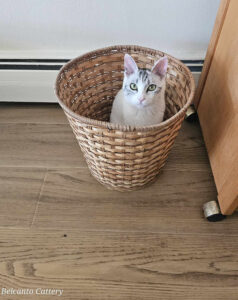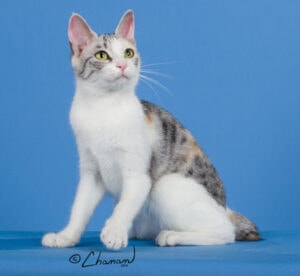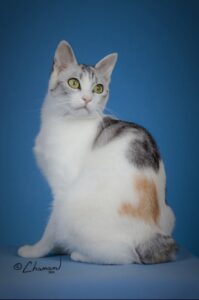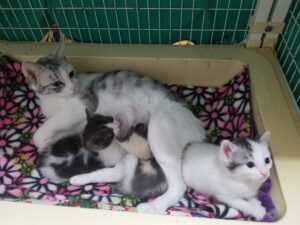Japanese Bobtails
while providing an endless source of entertainment!
These days, JBTs are more likely to be found doing battle with feathers or catnip toys, or staking their claim to your favorite chair. They are extremely “helpful” (i.e., NOT) around the house and take a keen interest in all your activities. We have been charmed by the many similarities between the JBTs and our beloved Turkish Angoras, but find the JBTs tend to be slightly calmer and less intense than the Turks we have known.

Coat
Japanese Bobtails are bred and shown in two coat lengths. The Longhair JBTs have a wonderfully silky coat that always looks a bit windflower and enhances the natural beauty of these cats. The Shorthairs have a coat length that is described as “medium” with a soft, close-lying texture. While neither type is known for heavy shedding, we strongly recommend a weekly combing session to help control the amount of cat hair that may end up decorating your clothes and furniture.
Thus far, we have focused our breeding on Shorthair JBTs and have no current plans to expand into Longhairs. But never say never! (In the meantime, we can refer you to other breeders who do work with Longhairs.)
Type, Structure, and Color
As befits their hunting history, these cats are strong and muscular, but your first visual impression is one of refinement and elegance. JBTs stand high on long, fine-boned front legs and deeply angulated back legs that enable them to jump effortlessly to the top of the refrigerator in a single bound. Their heads are reminiscent of an equilateral triangle, with large, soulful oval eyes and erect ears set ar right angles to the head. The body is slender, medium to long, but never tubular like an Oriental or Siamese; it is classified as a “medium foreign” body shape.
JBTs are found in any genetically possible cat color, including solids, tabbies, bicolors and particolors, pointed, pointed and white. . .you name it! The TICA standard places greater value on bold, vivid markings, the flashier the better! We are seeking to produce “mi-ke” (three-color in Japanese) and bicolor cats, preferable silver and white, black and white or red and white.
Personality
Stories about the mayhem and chaos that JBTs can bring into a household abound. Their intelligence, curiosity, and playful nature enables them to identify and create their own toys (which may very well have other important purposes in your home!). While providing an abundant supply of toys specifically designed for cats is strongly recommended, we must also note that our Bobtails seem less mischievous than average. This may very well be due to the companionship of our Siberians, who are typically quite calm and mellow most of the time.
JBTs find their owners a source of endless fascination and can usually be found close by their special person, watching to see what he or she might decide to do next. While they do generally identify a favorite member of those household, most are delighted to receive human attention from anyone, anytime, anywhere!
About Folie a Deux Japanese Bobtails
With two breeding programs under one roof, we had taken note of several other breeds that appealed to us – JBTs among them –but had absolutely no intention of becoming seriously involved with a third breed.
That determination began to waver when Carol Schwartz, a JBT breeder from Pennsylvania, died suddenly, leaving nearly 30 cats in need of homes. When first asked to take one in, we refused. . .but then we were offered a silver tabby and white female, one of our favorite colors. Carol’s breeding program had focused on silvers and bicolors, and she had been very supportive of Iris’s judging career. Ultimately, we took the girl in, named her “Tara,” and began looking for a male to produce JUST ONE LITTER to preserve Carol’s line.
This led to our relationship with former TICA Judge Jimmy Reardon. Tara was bred to one of Jimmy’s males and produced Kaiitos Kobe of Folie a Deux, who eventually became a CFA grand champion. However, tragedy struck again. Jimmy died suddenly just as Kobe was giving birth to her first litter. Iris found herself taking on the responsibility of finding homes for Jimmy’s cats and in so doing, established relationships with most of the JBT breeders in CFA and TICA.
By the time this labor of love was completed, it was clear that Folie a Deux Japanese Bobtails had become a “thing,” whether we wanted them to happen or not. We are now showing and breeding our SH JBTs in TICA and plan to continue doing so for at least several more years.
The gentle, loving nature of the JBT comes hand in hand with a quiet determination that usually enables them to get what they want. They certainly wanted us!!




